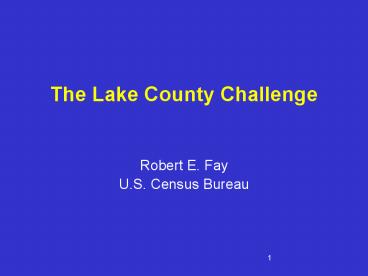The Lake County Challenge - PowerPoint PPT Presentation
1 / 23
Title: The Lake County Challenge
1
The Lake County Challenge
- Robert E. Fay
- U.S. Census Bureau
2
General guidance on analyzing ACS
- NRC (2007) (Citro and Kalton, eds.)
- Report examined approaches to analysis
- 10 guidelines in the Executive Summary
- 1st guideline Always examine margins of error
before drawing conclusions from a set of
estimates.
3
General guidance
- Beaghen and Weidman (2007)
- General overlap but some shift of emphasis
- Example from Lake County, Illinois
- - speak Spanish at home
- - Universe age 5, including group quarters
- - Asked in 1990, 2000 censuses, ACS
4
Lake County
5
The Lake County Challenge
- Challenge in handout
- - Lake County 644,599 in Census 2000
- - Can we identify subcounty trends?
- - Best professional effort standard
6
Draft paper
- Analyses for
- 18 Townships
- 5 PUMAs
- Doesnt take up
- Places too complicated geographically
- Tracts too complicated statistically
7
Ambition second paper on tracts
- Benjamini and Hockberg (1995) JRSSB
- Controlling the False Discovery Rate a
Practical and Powerful Approach to Multiple
Testing - - apply false discovery rate calculations to
tract-level analysis
8
Townships
9
Townships
- Start with 1990 2000 trends
- Increases in all 18 townships (a few n.s.)
- 1/2 in Waukegan
- 2/3 in Waukegan, Avon, and Zion
- (26 of 2000 county population)
10
Townships
- Propose (Table 1 from 1990/2000 data)
- Group 4 Waukegan 21 growth
- Group 3 AvonZion 9 growth
- Group 2 7 townships with 3-6 growth
- Group 1 8 townships
11
Townships
- 1-year ACS data cant be used
- Table 2 1999-2001 vs. 2003-2005
- Non-overlapping 3-year period estimates
- Gaps 11 out of 18 townships
12
Townships
- Table 3 1999-2003 vs. 2001-2005
- Overlapping 5-year period estimates
- No gaps, can construct groups 1-4
- Significant increases in all 4 groups
- Group 2 now accounting for larger share of growth
13
Townships
- Table 4 Comparing annualized change
- When trend nearly linear, annualized change for
11 townships quite similar - 3-year 1999-2001 to 2003-2005 (4 years)
- 5-year 1999-2003 to 2001-2005 (2 years)
- Both for estimates and standard errors
14
PUMAs
- Public Use Microdata Areas
- 100,000 population
- ACS publishes annually
- NRC (2007) recommended as possible level of
analysis
15
PUMAs
16
PUMAs
- Start with 1990 2000 trends
- Must approximate from townships
- AFF doesnt provide tables
- Table 6 (in draft)
17
Table 6 PUMAs 1990-2000
18
PUMAs
- 1-year ACS data erratic, hard to analyze
- 3-year, 1999-2001 vs. 2003-2005,
- - non-overlapping, in Table 7
- 5-year, 1999-2003 vs. 2001-2005,
- - overlapping, in Table 8
19
Table 9 Annualized Change
20
Discussion Guidelines
- Case study calls into question recommendation to
avoid analysis of overlapping periods. - In other respects, does case study fall within
NRC guidance?
21
Discussion Geographic level
- NRC report suggests difficult to use ACS to
track change, except for large areas - The case study appears to agree
- grouped townships into larger areas
- PUMA-level analysis possible
22
Discussion Helping users
- Possible consideration PUMA results from 1990
and 2000 censuses - Standard errors for simple aggregates
- Possible displays of differences, trends?
23
Discussion Tools
- The analysis was time consuming
- Primarily in Excel, but new study would require
almost starting over - Possible role for the R statistical software?
Another approach?































